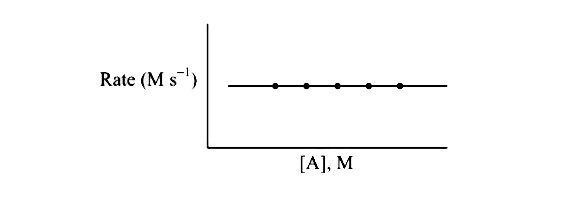For a given reaction A→ Product, rate is 1×10−4Ms−1 when [A]=0.01M and rate is 1.41×10−4Ms−1 when [A]=0.02M. Hence, rate law is :
−d[A]dt=k[A]2
−d[A]dt=k[A]
−d[A]dt=k4[A]
−d[A]dt=k[A]1/2
The correct Answer is:4
To solve the problem, we need to derive the rate law for the reaction A→Product using the given rates and concentrations of reactant A.
1. Identify the Given Data:
- Rate R1=1×10−4M s−1 when (A1)=0.01M
- Rate R2=1.41×10−4M s−1 when (A2)=0.02M
2. Write the Rate Law:
For a reaction of the form A→Product, the rate law can be expressed as:
R=k(A)n
where k is the rate constant and n is the order of the reaction.
3. Set Up the Equations:
From the first set of data:
R1=k(A1)n⟹1×10−4=k(0.01)n(1)
From the second set of data:
R2=k(A2)n⟹1.41×10−4=k(0.02)n(2)
4. Divide the Two Equations:
To eliminate k, divide equation (1) by equation (2):
1×10−41.41×10−4=k(0.01)nk(0.02)n
This simplifies to:
11.41=(0.010.02)n
11.41=(12)n
5. Solve for n:
Taking logarithms on both sides:
log(11.41)=nlog(12)
Rearranging gives:
n=log(11.41)log(12)
Calculating the values:
n≈−0.1461−0.3010≈0.485≈12
6. Write the Final Rate Law:
Now that we have n, we can write the rate law as:
R=k(A)1/2
or in terms of the rate of change of concentration:
−d(A)dt=k(A)1/2
Final Answer:
The rate law for the reaction is:
−d(A)dt=k(A)1/2
- Rate R1=1×10−4M s−1 when (A1)=0.01M
- Rate R2=1.41×10−4M s−1 when (A2)=0.02M
For a reaction of the form A→Product, the rate law can be expressed as:
R=k(A)n
where k is the rate constant and n is the order of the reaction.
From the first set of data:
R1=k(A1)n⟹1×10−4=k(0.01)n(1)
From the second set of data:
R2=k(A2)n⟹1.41×10−4=k(0.02)n(2)
To eliminate k, divide equation (1) by equation (2):
1×10−41.41×10−4=k(0.01)nk(0.02)n
This simplifies to:
11.41=(0.010.02)n
11.41=(12)n
Taking logarithms on both sides:
log(11.41)=nlog(12)
Rearranging gives:
n=log(11.41)log(12)
Calculating the values:
n≈−0.1461−0.3010≈0.485≈12
Now that we have n, we can write the rate law as:
R=k(A)1/2
or in terms of the rate of change of concentration:
−d(A)dt=k(A)1/2
The rate law for the reaction is:
−d(A)dt=k(A)1/2
Topper's Solved these Questions
- CARBONYL COMPOUNDS (ALDEHYDES & KETONES ) & CARBOXYLIC ACID Book:RESONANCE ENGLISHChapter:CARBONYL COMPOUNDS (ALDEHYDES & KETONES ) & CARBOXYLIC ACID Exercise:Part -IV
Explore 23 Videos
- CHEMISTRY IN EVERYDAY LIFEBook:RESONANCE ENGLISHChapter:CHEMISTRY IN EVERYDAY LIFEExercise:ORGANIC CHEMISTRY(Chemistry in every day life)
Explore 31 Videos
Similar Questions
For the reaction A + H2O → products, find the rate of the reaction when [A] = 0.75 M, k= 0.02.
View SolutionFollowing reaction can take place in both direction Ak1k2B. For the forward reaction and for the backward direction
[B]Rate0.01M1×10−2Ms−10.02M2×10−2Ms−1
Hence, net reaction rate is :

View Solution
Knowledge Check
The rate constant for the reaction, 2N2O5→4NO2+O2 is 3.0×10−5s−1. If the rate is 2.40×10−5molL−1s−1, then the initial concentration of N2O5 (in molL−1) is
A0.8B0.7C1.2D1
Identify the reaction order from each of the following rate :
k=3.1×10−4s−1
View SolutionIdentify the reaction order from each of the following rate :
k=3.1×10−4s−1
View SolutionIdentify the reaction order from each of the following rate :
k=3.1×10−4s−1
View SolutionFor a first order for the reaction A→ products : the rate of reaction at [A]=0.2M is 1.0×10−3molL−1s−1. The reaction will occur to 75% completion in .
View SolutionThe rate of a reaction increases four-fold when the concentration of reactant is increased 16 times. If the rate of reaction is 4×10−6molL−1s−1 when the concentration of the reactant is 4×10−4molL−1. The rate constant of the reaction will be
View SolutionAt 407K, the rate constant of a chemical reaction is 9.5×10−5s−1 and at 420K, the rate constant is 1.9×10−4s−1. Calculate the Arrhenius parameter of the reaction.
View SolutionThe rate constant of a reaction is 1.5×10−4s−1 at 27∘C and 3×10−4s−1 at 127∘C. The Ea is
View Solution
